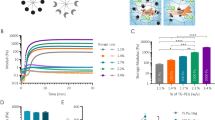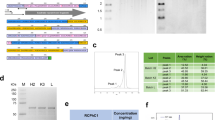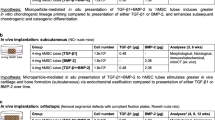Abstract
We have engineered synthetic poly(ethylene glycol) (PEG)–based hydrogels as cell-ingrowth matrices for in situ bone regeneration. These networks contain a combination of pendant oligopeptide ligands for cell adhesion (RGDSP) and substrates for matrix metalloproteinase (MMP) as linkers between PEG chains. Primary human fibroblasts were shown to migrate within these matrices by integrin- and MMP-dependent mechanisms. Gels used to deliver recombinant human bone morphogenetic protein-2 (rhBMP-2) to the site of critical- sized defects in rat crania were completely infiltrated by cells and were remodeled into bony tissue within five weeks. Bone regeneration was dependent on the proteolytic sensitivity of the matrices and their architecture. The cell-mediated proteolytic invasiveness of the gels and entrapment of rhBMP-2 resulted in efficient and highly localized bone regeneration.
This is a preview of subscription content, access via your institution
Access options
Subscribe to this journal
Receive 12 print issues and online access
$209.00 per year
only $17.42 per issue
Buy this article
- Purchase on Springer Link
- Instant access to full article PDF
Prices may be subject to local taxes which are calculated during checkout






Similar content being viewed by others
References
Kingsley, D.M. What do BMPs do in mammals: clues from the mouse short-ear mutation. Trends Genet. 10, 16–21 (1994).
Wozney, J.M. & Rosen, V. Bone morphogenetic protein and bone morphogenetic protein gene family in bone formation and repair. Clin. Orthop. 346, 26–37 (1998).
Schmitt, J.M., Hwang, K., Winn, S.R. & Hollinger, J.O. Bone morphogenetic proteins: an update on basic biology and clinical relevance. J. Orthop. Res. 17, 269–278 (1999).
Wozney, J.M. et al. Novel regulators of bone formation: molecular clones and activities. Science 244, 1528–1534 (1988).
Fiedlaender, G.E. et al. Osteogenic protein-1 (bone morphogenetic protein-7) in the treatment of tibial nonunions. J. Bone Joint Surg. 83A, 151–189 (2001).
Li, R.H. & Wozney, J.M. Delivering on the promise of bone morphogenetic proteins. Trends Biotechnol. 19, 255–265 (2001).
Brekke, J. & Toth, J. Principles of tissue engineering applied to programmable osteogenesis. J. Biomed. Mat. Res. 43, 365–373 (1998).
Uludag, H. et al. Implantation of recombinant being bone morphogenetic proteins with biomaterial carriers, a correlation between protein pharmacokinetics and osteoinduction in the rat ectopic model. J. Biomed. Mater. Res. 50, 227–238 (2000).
Boyne, P.J. Animal studies of application of rhBMP-2 in maxillofacial reconstruction. Bone 19, 83–92 (1996).
Hollinger, J.O. et al. Recombinant human morphogenetic protein-2 and collagen for bone regeneration. J. Biomed. Mater. Res. (Appl. Biomater.) 43, 356–364 (1998).
Ellingsworth, L.R., DeLustro, F., Brennan, J.E., Sawamura, S. & McPherson, J. The human immune response to reconstituted bovine collagen. J. Immunol. 136, 8877–8882 (1986).
DeLustro, F., Dasch, J., Keefe, J. & Ellingsworth, L. Immune responses to allogeneic and xenogeneic implants of collagen and collagen derivates. Clin. Orthop. 260, 263–279 (1990).
Boestman, O. Foreign-body reactions to fracture fixation implants of biodegradable synthetic polymers. J. Bone Joint Surg. 73B, 592–596 (1990).
Meikle, M.C. et al. Effect of poly dl-lactide-co-glycolide implants and xenogeneic bone matrix-derived growth factors on calvarial bone repair in the rabbit. Biomaterials 15, 513–521 (1994).
Kenley, R. et al. Osseos regeneration in the rat calvarium using novel delivery systems for recombinant human bone morphogenetic protein-2 (rhBMP-2). J. Biomed. Mater. Res. 28, 1139–1147 (1994).
Zegzula, D., Buck, D.C., Brekke, J., Wozney, J.M. & Hollinger, J.O. Bone formation with use of rhBMP-2 (recombinant human bone morphogenetic protein-2). J. Bone Joint Surg. 79A, 1778–1790 (1997).
Ertel, S.I. Evaluation of poly(d-carbonate), a tyrosine-derived degradable polymer, for orthopedic applications. J. Biomed. Mater. Res. 29, 1337–1348 (1995).
Anseth, K.S., Sharstri, V.R. & Langer, R. Photopolymerizable degradable polyanhydrides with osteocompatibility. Nat. Biotechnol. 17, 156–159 (1999).
Zhu, G., Mallery, S.R. & Schwendeman, S.P. Stabilization of proteins encapsulated in injectable poly(lactide-co-glycolide). Nat. Biotechnol. 18, 52–57 (1999).
Saito, N. et al. A biodegradable polymer as a cytokine delivery system for inducing bone formation. Nat. Biotechnol. 19, 332–335 (2001).
Hubbell, J.A. Bioactive biomaterials. Curr. Opin. Biotechnol. 10, 123–129 (1999).
Griffith, L.G. & Naughton, G. Tissue engineering—current challenges and expanding opportunities. Science 295, 1009–1014 (2002).
Pratt, A.B. & Hubbell, J.A. Cell-responsive Synthetic Biomaterials Formed In Situ (California Institute of Technology, Pasadena, CA, 2001).
Halstenberg, S., Panitch, A., Rizzi, S., Hall, H. & Hubbell, J.A. Biologically engineered protein-graft-poly(ethylene glycol) hydrogels: a cell adhesive and plasmin-degradable biosynthetic material for tissue repair. Biomacromolecules 3, 710–723 (2002).
Gobin, A.S. & West, J.L. Cell migration through defined, synthetic ECM analogs. FASEB 16, 751–753 (2002).
Clark, R.A.F. Molecular and Cellular Biology of Wound Repair (Plenum Press, NY, 1996).
Woessner, J.F. & Nagase, H. Matrix Metalloproteinases and TIMPs (Oxford Univ. Press, New York, 2000).
Sternlicht, M.D. & Werb, Z. How matrix metalloproteinases regulate cell behavior. Annu. Rev. Cell Dev. Biol. 17, 463–516 (2001).
Vu, T.H. & Werb, Z. Matrix metalloproteinases: effectors of development and normal physiology. Genes Dev. 14, 2123–2133 (2000).
West, J.L. & Hubbell, J.A. Separation of the arterial wall from blood contact using hydrogel barriers reduces intimal thickening after balloon injury in the rat: the roles of medial and luminal factors in arterial healing. Proc. Natl. Acad. Sci. USA. 93, 13188–13193 (1996).
Weber, F.E., Eyrich, G., Graetz, K.W., Maly, F.E. & Sailer, H.F. Slow and continuous application of human recombinant bone morphogenetic protein via biodegradable poly(lactide-co-glycolide) foamspheres. Int. J. Oral Maxillofac. Surg. 31, 60–65 (2002).
Ruppert, R., Hoffmann, E. & Sebald, W. Human bone morphogenetic protein 2 contains a heparin-binding site which modifies its biological activity. Eur. J. Biochem. 237, 295–302 (1996).
Patel, S., Cudney, B. & MacPherson, A. Polymeric precipitants for the crystallinization of macromolecules. Biochem. Biophys. Res. Commun. 207, 819–828 (1995).
Uludang, H. et al. rhBMP-collagen sponges as osteoinductive devices: effects of in vitro sponge characteristics and protein pi on in vivo rhBMP pharmacokinetics. Ann. New York Acad. Sci. 875, 369–378 (1999).
Elbert, D.L., Pratt, A.B., Lutolf, M.P., Halstenberg, S. & Hubbell, J.A. Protein delivery from materials formed by self-selective conjugate addition reactions. J. Contr. Rel. 76, 11–25 (2001).
Weber, F.E. et al. Disulfide bridge conformers of mature BMP are inhibitors for heterotopic ossification. Biochem. and Biophys. Res. Commun. 268, 554–558 (2001).
European Agency for the Evaluation of Medicinal Products. European Public Assessment Report: osteogenic protein 1 (Cpmp/0393/01). http://www.eudra.org/ humandocs/humans/epar/osteogenicprot1/osteogenicprot1.htm (2001).
Lutolf, M.P., Tirelli, N., Cerritelli, S., Cavalli, L. & Hubbell, J.A. Systematic modulation of Michael-type reactivity of thiols through the use of charged amino acids. Bioconj. Chem. 12, 1051 (2001).
Muller, R. & Ruegsegger, P. Micro-tomographic imaging for the nondestructive evaluation of trabecular bone architecture. Stud. Health Technol. Infor. 40, 61–79 (1997).
Odgaard, A. & Gundersen, H.J. Quantification of connectivity in cancellous bone, with special emphasis on 3-D reconstructions. Bone 14, 173–182 (1993).
Muller, R., Hildebrand, T. & Ruegsegger, P. Noninvasive bone-biopsy—a new method to analyze and display the 3-dimensional structure of trabecular bone. Phys. Med. Biol. 39, 145–164 (1994).
Acknowledgements
Funding of this study was provided by the Swiss National Science Foundation (NFP46 grant 58681), the Swiss Federal Agency for Education and Science (01.0224), and the European Union Framework 5 Program (C5RD-CT-2000-00267). We thank A. Zisch and G. Raeber for helpful discussions.
Author information
Authors and Affiliations
Corresponding author
Ethics declarations
Competing interests
The materials employed in this study are the subject of patents that are held by the Swiss Federal Institute of Technology and the University of Zurich. These patents have been licensed by Kuros Biosurgery AG, in which the Swiss Federal Institute of Technology, the University of Zurich, and some of the authors hold equity, and by which some of the authors are employed as consultants.
Rights and permissions
About this article
Cite this article
Lutolf, M., Weber, F., Schmoekel, H. et al. Repair of bone defects using synthetic mimetics of collagenous extracellular matrices. Nat Biotechnol 21, 513–518 (2003). https://doi.org/10.1038/nbt818
Received:
Accepted:
Published:
Issue Date:
DOI: https://doi.org/10.1038/nbt818
This article is cited by
-
Recent developments of biomaterial scaffolds and regenerative approaches for craniomaxillofacial bone tissue engineering
Journal of Polymer Research (2022)
-
LED photobiomodulation therapy combined with biomaterial as a scaffold promotes better bone quality in the dental alveolus in an experimental extraction model
Lasers in Medical Science (2022)
-
Individualized plasticity autograft mimic with efficient bioactivity inducing osteogenesis
International Journal of Oral Science (2021)
-
Interplay of reactive oxygen species (ROS) and tissue engineering: a review on clinical aspects of ROS-responsive biomaterials
Journal of Materials Science (2021)
-
A bioengineering perspective on modelling the intestinal epithelial physiology in vitro
Nature Communications (2020)



